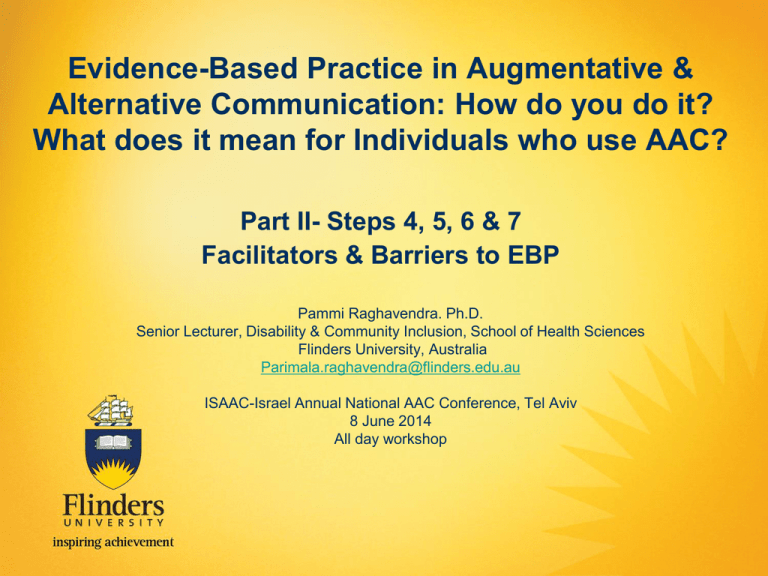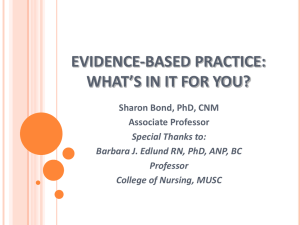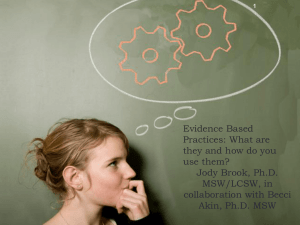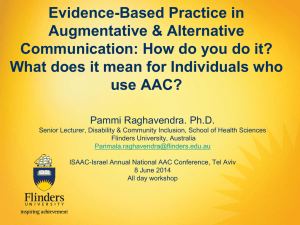Evidence-Based Guideline
advertisement

Evidence-Based Practice in Augmentative & Alternative Communication: How do you do it? What does it mean for Individuals who use AAC? Part II- Steps 4, 5, 6 & 7 Facilitators & Barriers to EBP Pammi Raghavendra. Ph.D. Senior Lecturer, Disability & Community Inclusion, School of Health Sciences Flinders University, Australia Parimala.raghavendra@flinders.edu.au ISAAC-Israel Annual National AAC Conference, Tel Aviv 8 June 2014 All day workshop Part II 1. 2. 3. What is EBP? What does EBP mean for individuals who use AAC and other stakeholders? Steps involved in EBP – 7 steps 1. 2. 3. 4. 5. 6. 7. 4. 5. 6. 7. Asking a clinically relevant & answerable question (Group work) Searching for the evidence Critically appraising the evidence (Group work) Collating & synthesising the evidence – Developing a CAT Implementing the evidence into practice Evaluating the use of the evidence Disseminating the EBP process & findings Facilitators and barriers to EBP (Group work) Practical Suggestions to implement EBP Nature and extent of evidence in AAC What can you do to add evidence to the AAC field? Step 4. Collating & Synthesising the evidence What types of interventions enhance the participation of AAC users in school settings?” “What factors influence the participation of AAC users in school settings Overview of Articles Appraised 10 Experimental - Single Subject (SSED) 8 Experimental - Group 2 1 Meta-Analysis of SSED 3 10 5 Surveys 5 7 Reviews 5 Case Studies 7 8 5 1 2 Observational Studies 3 Qualitative Studies Aims Stated Topic Defined Broad Literature Review Variables Stated Clearly Study Design Described Pilot Study Ethical Practices Source of Population Random Sampling Random Assignment Arthur, M, Butterfield, N. & McKinnon, D. 1998 1 1 1 1 1 0 1 1 NA NA Beck, A. & Dennis, M. 1996 1 1 1 1 0 0 1 1 0 1 Beck, A., Fritz, H., Keller, A. & Dennis, M. Beck, A., Kingsbury, K., Neff, A. & Dennis, M. 2000 1 1 1 1 1 0 0 1 0 0 2000 1 1 1 1 1 0 1 1 1 1 Author Year Step 4 - Summarising the Evidence Step 4 – Summarising the Evidence Author(s) Carter, M. & Maxwell, K. Year Title 1998 Promoting interaction with children using augmentative communication through a peer-directed intervention Hughes, C., Rung, L., Wehmeyer, M., Agran, M., Copeland, S. & Hwang, B. Design Participants To examine the effects of a Experimental - 4 AAC users with partner-directed Group CP (3 boys, 1 girl); intervention program on 30 typically the social interaction developing between regular peers & children young AAC users within a classroom setting Intervention(s) Results Peer training resulted in increase in social interactions by peers & by AAC users Peers attended 6 lessons covering mutual attention to play activity, commenting on activities, acknowledgement of partner's behaviours 1993 Using the milieu approach to To determine whether SSED 15 year old boy Expectant look, increase spontaneous milieu techniques would be multiple with autism & question, mand & communication book use effective in teaching probe across mental retardation model; across environments by an communication book use settings reinforcement of adolescent with autism communication book use & signing Direct observation coding of 11 communicative behaviours (verbal & nonverbal) Peer intervention resulted in improved rates of social interaction during play for 4/5 autistic children 2000 Self-prompted communication book use to increase social interaction among high school students Observation of initiations by participants when interacting with communication partners (5 minutes/day) To determine whether SSED peers without disabilities ABCB can be taught to use reversal strategies to facilitate communicative interactions with autistic preschoolers To examine the effects of self-prompted communication book training provided by peers on conversational initiations Instruction of peers in how to interact with AAC users (eg. strategies such as: look, ask, wait, respond) Evaluation tools/processes Recording of intervals with interaction by subjects & intervals with interaction by peers, use of intervention strategies Goldstein, H., 1992 Peer-mediated intervention: Kaczmarek, L., Attending to, commenting Pennington, R. & on, & acknowledging the Shafer, K. behavior of preschoolers with autism Hamilton, B. & Snell, M. Aim 5 boys with language, social & cognitive deficits + 10 typically developing children (5 boys & 5 girls) SSED 5 high school multiple students (4 male, 1 baseline female) across participants with multiple probe component Self-prompted communication book training provided by peers Recording of Mileu training was spontaneous effective responses, expectant look prompts, mand prompts & incorrect responses Training led to increase in appropriate initiations & decrease in inappropriate initiations Develop a CAT- Critically Appraised Topic What is a CAT or Critically Appraised Topic? A CAT is a short summary of evidence on a topic of interest, usually focussed around a clinical question. www.otcats.com, McCluskey, A., Characteristics of a CAT • A CAT is a shorter and less rigorous version of a systematic review • Summarises the best available research evidence on a topic • Usually more than one study is included in a CAT www.otcats.com, McCluskey, A., CAP (Critically Appraised Paper) When a single study/paper is critically appraised and summarised, it is called a CAP. • Can become part of a CAT or can stand alone www.otcats.com, McCluskey, A., How do you develop a CAT? Follow the same EBP Process 1. Asking a clinically relevant & answerable question-PICO/PESICO 2. Searching for the evidence How do you develop a CAT? Strategies for Searching Search for current best evidence 1) look for pre-filtered evidence, e.g., Cochrane 2) look for reviews before individual studies 3) look for peer-reviewed before non-peer reviewed Include and appraise only those articles that are relevant to your question (Schlosser, Wendt, Angermeier & Shetty, 2005) How do you develop a CAT? 3. Critically appraise the evidence, • Use appraisal checklists where applicable – Internal validity – Social validity – External validity • Apply the level of hierarchy of evidence (Joanna Briggs & Schlosser & Raghavendra (2004) How do you develop a CAT? • Examine the evidence for certainty/Strength of evidence ( Millar, Light & Schlosser, 2006, based on NL Smith & Simeonsson & Bailey, 1995) – Conclusive (design provided tight experimental control, adequate or better dependent variable reliability, treatment integrity) – Preponderant (study had minor flaws with respect to design with adequate or better dependent variable reliability, treatment integrity) – Suggestive (several minor flaws, inadequate DV &TI leading to conclusions that the outcome was plausible but not certain) – Inconclusive evidence (significant flaws in design, fails to establish experimental control) How do you develop a CAT? • Tabulate the articles • WRITE the CAT – 1 page summary with clinical bottom line – Keep it in an accessible place at work so that you and your colleagues can access it easily – Put it on a website, CAT bank or submit to a journal Examples of a CAT Examples resources • www.otcats.com • http://www.nswspeechpathologye bp.com.au/critically-appraisedpapers-and-topics Advantages of a CAT (Wendt, 2006) • Based on everyday clinical scenarios, so highly motivating for clinicians and students • By focusing on the research evidence, one gains experience in several steps in EBP process • Writing CATs can be part of university educational programs • For established practitioners & researchers, provides a framework for writing up discussions and outcomes form journal clubs & other forums Limitations of CATs (Wendt, 2006) • CAT can be inaccurate or wrong – No peer review – Done in short time, may have missed key evidence, poor appraisal • Short Shelf life – New evidence replaces older evidence – Constant updating is needed Challenges in developing a CAT – Lack of time and skills Step 4. Synthesising the Evidence: Interpreting study findings What is the evidence telling me? Validity (truth) and usefulness (clinical relevance) How does it match with my client and their environment? Who are the stakeholders? What are their beliefs and expectations? Step 5: Implementing the evidence into practice • Integrate the research evidence with clinical expertise and patient/client preferences to make clinical decisions • Development of clinical/practice guidelines How can we promote “clinical expertise”? • • • • • Continuing education Peer support and review Mentoring Discussion forums/Journal clubs Incentives / rewards How can we promote the integration of clinical expertise, client’s perspectives & research evidence? • Role model integration • Explicitly articulate & share examples of integration and ways to communicate with clients • Involvement in research activities • Mentoring What are Practice/Clinical guidelines? Research to Guidelines Pathway: the journey from research to clinical practice Judi Strid - Women's Health Action, www.nzgg.org.nz, accessed 30.6.07 Guidelines: Can be recommendations based on consensus agreement, expert opinion or experience. Some forms of evidence may also be included. The guideline provides the recommended approach but not the practical “how to” details specified in a protocol or pathway. Best Practice guidelines: Based on expert opinion generally used when evidence is limited, of poor quality or conflicting. What are Evidence-based guidelines? Research to Guidelines Pathway: the journey from research to clinical practice Judi Strid - Women's Health Action, www.nzgg.org.nz, accessed 30.6.07 Evidence-Based Guideline • Based on evidence which is explicitly stated and includes levels of evidence • The guideline is a tool for transferring research findings into a guide for clinical practice • • • Follows a clear format and process which is described within the guideline so it can be readily replicated. An algorithm or flowchart can be included to provide easy to follow steps that reflect the recommendations outlined in detail within the guideline Should be developed in a collaborative manner (to avoid duplication) and involve a multidisciplinary approach with consumer input Where to find evidence-based practice guidelines? (ASHA website, 2009) • http://www.asha.org/ • http://www.asha.org/members/compendiumSearchResults.aspx ?type=0&searchtext=Augmentative%20and%20Alternative%20 Communication Step 6. Evaluating the implementation of EBP 1. Has the EB intervention/assessment with clients’ input changed outcomes for clients? 1. SSED, systematic collection of data from clients 2. Are the guidelines appropriate & effective? 3. Monitoring your clinical expertise, your ability to communicate with clients, 4. Do we need to make any changes to our practice? If yes, what are they? 5. Are there questions that need further investigation? 6. What new information is known? Updating the evidence Step 7. Dissemination of EBP process & results • Share the process & outcomes of EBP with colleagues, work site seminars, at state, national and international conferences • Submit CATs to a CAT Bank • Submit SR and other research to journals • Use the EBP process when you plan your own research • Aim to conduct rigorous research and thus contribute to high quality evidence The Change to EBP The shift to EBP requires major change in attitudes, behaviors and routines Barriers to implement EBP Two surveys show limited use of research/theory in practice in OT (Dobson 2001; Forsyth & Hamliton, in press;cited in Forsyth et al., 2005) 1. 2. 3. 4. 5. 6. Information mismatch between research/theory- and practice Lack of time to read research evidence Lack of time to reflect Willingness to change intervention approach based on evidence Knowledge and skills needed to understand research articles written for other researchers Lack of organizational and/or professional support Group Work Activity 5 – Barriers & Facilitators Factor Patient/Client EBP process—7 steps Team Issues Care/service process Management Support Time/facilities/cost Health System Other Potential barrier(s)/Facilitators Examples of Positive Developments/Strategies • Two New Secondary Journals that reviews and appraise research with bottom-line messages – Evidence-Based Communication Assessment & intervention – Communication Disorders Review • Increase in the # of Systematic Reviews • Journals have a summary at the end of articles on what it means clinically –take home/key messages (e.g., Physiotherapy, AJOT, AJSLP) • Critically Appraised Topics & Papers (CATs & CAPs- e.g.,AJOT) • Development of Clinical/Practice guidelines How does a busy clinician incorporate evidence into everyday practice? (Corcoran,2006) 1) To make positive changes, requires attitudes, knowledge and skills 1) Attitudes: Ethical & professional responsibility 2) An hour to get started 3) Get a bird’s eye view of research available e.g., new journal JEBCAI; look for systematic reviews. • Bookmark most useful websites • Learn to search efficiently & effectively by using keywords to search favorite databases • Find services that’ll find info. for you, e.g., send alerts of new articles What our experiences have revealed • Training is essential • Appraisal of articles takes time and resources • Accuracy of responses in appraising varies (inter-rater reliability) • Compiling results of EBP reviews are a challenge • Integration of findings to re-evaluate current practice and potentially alter discipline practice takes time • Good library and information support • Sustainability needs to be factored in to the process Summary 1. Nature and extent of evidence in AAC 1. SR’s increasing 2. 2 new journals 3. Increased awareness of more rigorous research Summary • What can you do to add evidence to the AAC field? – – – – – Collect outcomes data systematically Look at that data; analyse; discuss Read, Read, Read; Ask, Ask, Ask Share your findings Collaborate with researchers and Practitioners As opposed to tradition or authority, EBP is a practice based on the integration of scientifically sound knowledge which incorporates both client values and perspectives and clinical expertise Workshop EVALUATION THANK YOU!!! References Robey, R., Apel, k., Dollaghan, C., Ellmo, W., Hall, N., Helfer, T., Moeller, M., Threats, t., Hooper, C. Kent, R., Drown, J., & Lonsbury-Martin, B. (2004). Report of the Joint coordinating committee on EBP. American Speech-Language-Hearing Association: Washington DC. Sackett, D. L., Richardson, W. S., Rosenberg, W., & Haynes, R. B. (1997). Evidence-based medicine: How to practice and teach EBM. New York: Churchill Livingstone. Schlosser, R. W. (2004, June 22). Evidence-based practice in AAC: 10 points to consider. The ASHA Leader, pp. 6-7, 10. Schlosser, R. W., & Raghavendra, P. (2003). Towards evidence-based practice in augmentative and alternative communication. In R. W. Schlosser, The efficacy of augmentative and alternative communication: Towards evidence-based practice (pp. 259-297). New York: Academic Press. Schlosser, R. W., & Raghavendra, P. (2004). Evidence-based practice in augmentative and alternative communication. Augmentative and Alternative Communication, 20(1), 1- 21. Tickle-Degnen, L. (2000). Gathering current research evidence to enhance clinical reasoning. American Journal of Occupational Therapy, 54(1),102-105.








